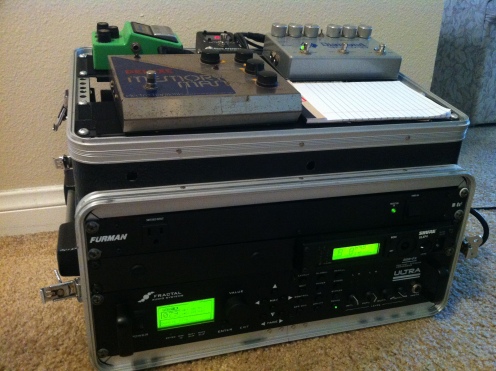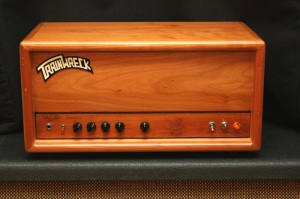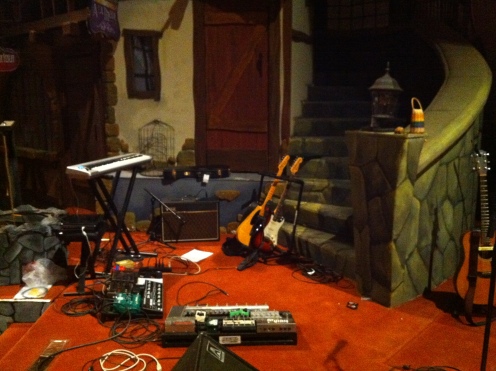Ok, so just a warning for those who aren’t interested in guitar gear, you can stop reading now. I won’t judge you. Seriously. This about to get into uncomfortable territory for you, like a professional athlete at a Renaissance fair.
As a preface, I’ve always hated digital gear. The only Line6 product I’ve ever owned was the DL4 and I didn’t even like that (volume drop, components they used to convert the analog signal to digital and back, etc). So for me, to hear about the AxeFX (fractalaudio.com), it was just another tempting product that promises flexibility and convenience but at the heavy cost of tone.
One thing about me: I HATE compromising tone. I would rather be inconvenienced than have it not sound “organic” or “textured”. I had a very complex rig up until the AxeFX involving boutique and vintage pedals, expensive wiring, etc. But with me getting married last year, it being OUR finances that would fund my pedal obsession, not knowing when we might get an unexpected blessing, I decided the wise thing to do as the leader of my family would be to try out the AxeFX and see if it could replace some gear. For a lot of people, the AxeFX has saved a lot of money, especially if they’re replacing expensive, boutique gear (the AxeFX cost about half of what was on my pedalboard at the time, so I thought if it works out, it’s a no brainer). So I tried it out.
 So here starts the actual review of the AxeFX for those who don’t want to read the ramble above. Just as a quick disclaimer, this review is mostly just an informative explanation of how I use the AxeFX and my findings of it’s merits and limitations. As a preface, I use the AFX as a direct rig with a QSC K12 as a monitor. I have it in a rackmountable case with several analog effects (mostly delays) that I can throw into the signal chain at any time via it’s effects loop in the back. The AxeFX has a VERY steep learning curve. I have had it for about 6 months and am just feeling like I’m starting to “get” it. The presets that it comes with are really meant to show off the effects not the amps, so most of them are drenched in thick choruses, compressors and auto-wahs. You’ll feel like you’re swimming in effects, and it is extremely hard to get a feel for how the amps inside actually sound. That’s when you gotta dig in and start from scratch. Pull up an amp and slap a speaker cabinet on, do some minor tweaking to the EQ, Drive and Master Volume to the amp, change out the cab for another, etc.
So here starts the actual review of the AxeFX for those who don’t want to read the ramble above. Just as a quick disclaimer, this review is mostly just an informative explanation of how I use the AxeFX and my findings of it’s merits and limitations. As a preface, I use the AFX as a direct rig with a QSC K12 as a monitor. I have it in a rackmountable case with several analog effects (mostly delays) that I can throw into the signal chain at any time via it’s effects loop in the back. The AxeFX has a VERY steep learning curve. I have had it for about 6 months and am just feeling like I’m starting to “get” it. The presets that it comes with are really meant to show off the effects not the amps, so most of them are drenched in thick choruses, compressors and auto-wahs. You’ll feel like you’re swimming in effects, and it is extremely hard to get a feel for how the amps inside actually sound. That’s when you gotta dig in and start from scratch. Pull up an amp and slap a speaker cabinet on, do some minor tweaking to the EQ, Drive and Master Volume to the amp, change out the cab for another, etc.
Most of the time, if you go online and look at YouTube videos of the AFX, you’ll see the metal and high gain tones it can do, which very well could be great, I’m just not a high-gain connoisseur (come on, the very fact that I just used that word…). What doesn’t get a lot of play on YouTube and very little recognition is the low-to-mid-gain tones it can get. THIS is where the AxeFX, in my mind, excels and where all other modelers fall short. The barely broken-up AC30 jangly tone. The TS-808 used as a clean boost into a Deluxe Reverb with it’s volume on 6. THIS is where the AFX really does it’s thing. The dynamics it produces are exactly what I’d expect from a real amp. You can use all those cliché tone-describing words for tube amps like “sparkle”. “chime”, “punch” to describe the AxeFX. The part that really surprised me the most was the feel of playing through the AFX. You can feel the simulated amp as you’re playing through it, just like with a normal amp. I used to run an AC30 pretty loudly in another room and feed it through my monitor live; it really feels like I’m playing through a similar setup with this unit.

So the main amp sim I use in the unit is a Trainwreck Express, an extremely boutique amp designed and built by Ken Fischer (named “Wrecker 1” in the AxeFX). For some reason when I was flipping through the amps one day, I just kept coming back to it for my “main tone”. I use this amp 65-70% of the time either by itself or with added effects. It’s very gain-sensitive, so it can go from clean to gritty to mid-gain crunch with just pick dynamics. Yet, no matter where on that spectrum you play, it’s very balanced with Class-A-like harmonically rich content. It is, IMO, a slightly less mid-rangy AC30 with a little more of a vintage Marshall sound. I’m currently using this amp with a simulated close-mic’d 4×12 Marshall cab with Celestion G12H30’s. Best part is, it cuts through perfectly in a live situation.
Now, everyone’s “main tone” is gonna sound different depending on where you need your guitar to fit into the mix given the instruments around you, what guitar you’re playing, what style of music you’re playing, etc. Every guitarist has (or is looking for) their “main tone”, where they sonically “set up camp” and derive other tones from. Contrary to popular belief of people that have never used modelers before (and I had to learn the hard way), you’re not gonna have every single preset feature a different amp. Out of the 70 different amps in the AxeFX, I only really use these 3:
• Trainwreck Express • Marshall Plexi (1959 Super Lead) • Dumble Overdrive Special
 I get a HUGE variety of tones with just these three. Do the other amp sims sound great, too? Heck yes!! I love playing around with different amps and developing different tones. I’ve already made my ideal Hiwatt DR103 tone and am developing my ideal ’59 Bassman tone. I’m starting to mess around with different presets, having different mic setups as well. With RedWirez, a third party speaker cabinet simulator company (how boring does that sound to someone who doesn’t play guitar??), you can have limitless mic configurations (i.e., 85% of the tone is an off-axis SM57 that is 2 inches away from the cap edge of the speaker, 15% is with a TC30 right up on the cone, etc.) But, in a live setting, you don’t want your tone to vary TOO much, especially within songs. BTW, you might find this out down the road, it doesn’t take much to make me want to put Edge’s setup into a post somehow. Talking about mic’ing amps seems the most relevant way to do that, next time might not be so relevant. 🙂
I get a HUGE variety of tones with just these three. Do the other amp sims sound great, too? Heck yes!! I love playing around with different amps and developing different tones. I’ve already made my ideal Hiwatt DR103 tone and am developing my ideal ’59 Bassman tone. I’m starting to mess around with different presets, having different mic setups as well. With RedWirez, a third party speaker cabinet simulator company (how boring does that sound to someone who doesn’t play guitar??), you can have limitless mic configurations (i.e., 85% of the tone is an off-axis SM57 that is 2 inches away from the cap edge of the speaker, 15% is with a TC30 right up on the cone, etc.) But, in a live setting, you don’t want your tone to vary TOO much, especially within songs. BTW, you might find this out down the road, it doesn’t take much to make me want to put Edge’s setup into a post somehow. Talking about mic’ing amps seems the most relevant way to do that, next time might not be so relevant. 🙂
The main thing I like about the AxeFX is the fact that my tone stays consistent every time I play through it. For me, constantly chasing tone with analog gear was a little difficult. When I had my AC30, I loved the sound of it cranked. It had this rich, complex sparkle in the top end that was amazing when it was warmed up right. But when it wasn’t, it was nice, but not quite “there.”
I have tweaked my main Trainwreck Express patch around a lot for it to accurately reflect the tone that’s in my head. It took a while, I’ll be honest. There was obviously a lot of passive EQ tweaking (like on the front of an amp), but I also messed around with stuff like the power tube bias, the bright cap nF value, details about the transformer, overall sag of the amp. And EVERY time I play out, I get that tone that I worked hard on dialing in. Consistency.
So that’s how the amps sound, which is, ultimately the most important part of a direct rig- how accurately you can reproduce the sound of a mic’d amp. Turns out pretty close. 🙂 As for the effects, I’m not going to get too deep into them as I have not really opened up the effects as much as the amps. The overdrives are overwhelmingly customizable. Subtle nuances which seem very small are changeable (clip type, bias, pre AND post EQ, etc); you can really create your own custom voicing for an overdrive. Delays, if programmed right, can sound very lush and analog-like. Yes, you have to tweak the crap out of it and add additional effects in front and behind the delay blocks in order to get there, as the delay sims are not sims of any analog pedals (tape, tube or bucket brigade). Still, when programmed right, they rival my Diamond Memory Lane 2 in lushness (it does involve a lot of work, though). Hopefully, they will be releasing analog delay sims in the next firmware release.
So overall, I still consider myself new to the AxeFX. There’s still some amp models I haven’t dug into. There’s still effects I’ve NEVER turned on. I really look forward to diving into other aspects of this thing, but if I only used it for what I’m using it for now (even as critical I am about tone), I personally like it better than any other rig I’ve owned. It has been an incredible blessing to not have to worry about how your tone is sounding (cuz it’s EXACTLY how it sounded last time, amazing) and just be able to worship.
-Paul
P.S. This was my last rig, btw. It’s nice to be able to look back on what you used to do and be able to laugh at how complicated it was. Not trying to slam anyone who still tap dances, but… I mean, come on. This was just ridiculous. 

